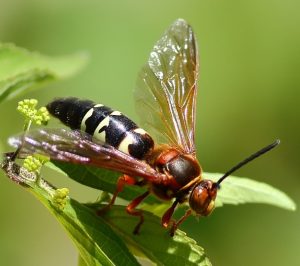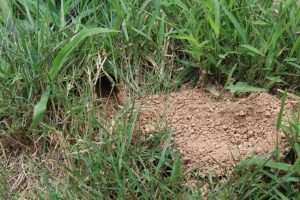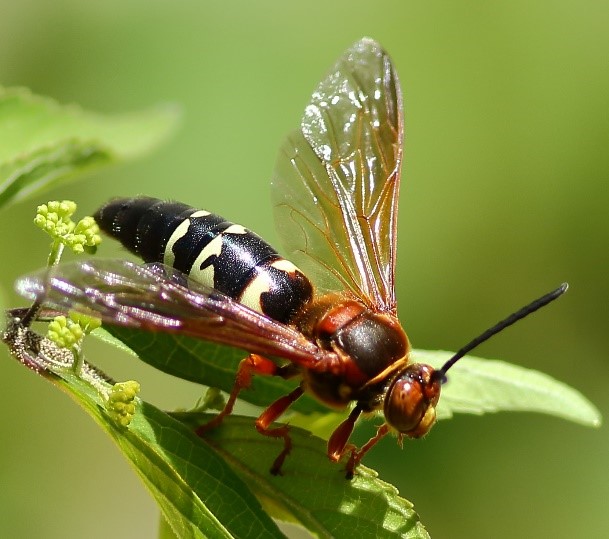
I spent a little time this morning weeding the gardens. On the east and sunny side of the house, huge wasps frequently bombed me, buzzing over my head, and aggressively coming at me as I worked. I don’t mind. I know the identification marks for the Eastern Cicada Killer, Sphecius speciosus, and this wasp provides no danger to me. Once must admit the aggressive behavior of the males can be daunting! Anyone who encounters a cicada killer remembers it. This wasp is huge 1 to 2 inches with reddish head and thorax, yellow legs, and a black andCCC yellow abdomen. The size alone is a dead giveaway to its identity.
In the 30 feet between my house and my neighbors, I count ten male Eastern Cicada Killers patrolling; three in my yard and 7 in my neighbors. How do I know they are male? If I had one in my hand (not a good idea as a female does sting) I could count the abdominal segments. A male has seven and a female only six. It is far easier to use the behavior as the identification key. The males have a one track mind—find a receptive female!
Male wasps have no true stinger. A wasps stinger is actually an ovipositor—an egg laying organ. For solitary wasps like the Eastern Cicada Killer, the stinger contains a poison used to paralyze the prey. For colonial species like hornets, only the queen lays eggs. All of the other females have a stinger which is used for defense. While an Eastern Cicada Killer female can sting, it won’t unless harassed or grabbed. The female also has a one track mind—raise young. Not being a colonial nester, the female Eastern Cicada Killer does not protect its nesting area. If disturbed, it can move on without risk of danger involved in approaching something and stinging it. It reserves the stinger for the primary purpose of paralyzing prey.
In July, the male Eastern Cicada Killers emerge first from their burrows. The male then stakes out a territory, about a square yard in size. This territory provides the male with a convenient perching spot, and an area of ground which includes some bare, dry, soil—a location a female would search for to build her nest. Once on territory, the male must check out everything that moves. Normally, an animal creates a search image for its desires be it the right size prey to eat, the current flower that provides a nectar source, or a member of its own species with which it might mate. It appears that the Eastern Cicada Killer’s search image includes anything from a tiny fly to a human being. Anything coming into the territory needs to be inspected and often driven off. Most often, another male while chasing something will intrude into a wasp’s territory. A chase ensues. This may extend for over 30 feet, which undoubtedly means it will overlap another male’s territory and a new battle begins. Usually, the “battle” consists of a chase and race. Occasionally, brief physical contact happens.

Sooner or later, a female enters the territory and then mating happens. Shortly after mating, the male dies. The female then proceeds to build and provision her nest. The nest consists of a tunnel about 10 inches deep with some side chambers. Each chamber will house a single larva. This tunnel digging can bring up a pound or more of dirt and can make a lawn look messy, but it is not dangerous!
Once completing a tunnel, the female wasp patrols the trees searching for a cicada. Once she finds one, she stings and paralyzes the cicada. Now she must move her prey to a previously prepared tunnel in the soil. Turning the immobile insect belly up, the cicada killer clutches her prey to her belly and makes a mad flight, losing altitude with every frantic wing beat; essentially a controlled crash. If she does not make it to the tunnel before striking the ground, the wasp must drag the cicada across the ground with every little blade of grass, leaf, and stone a major obstacle. Or, if it can, the wasp, flapping constantly, scrambles up a nearby object trying to gain some altitude before launching off again.
Once the hole is reached and the cicada is entombed in the tunnel. The cicada, drug down head first and belly up, probably could not escape even if it were not paralyzed. Often just one, but occasionally up to three cicada get stuffed into the tunnel and an egg is deposited on the cicada. The parent moves on to another chamber or another tunnel in an effort to lay as many eggs as she can before she dies in the autumn cold. She leaves her young well provisioned but with no other resources to assist the larva to survive. The wasp larva hatches and then feeds on the still living but paralyzed cicada waiting to eat the cicada’s vital organs just before the larva starts to pupate. As a pupa, the wasp essentially waits until the next season. (Who said nature was pretty? It is not, but it is remarkable.) The next year, the young wasp hatches and instinctively knows how to dig a tunnel, hunt cicadas, and paralyze its victim.
Years ago, my first experience with this species included using a gas powered lawn mower to cut the grass at my parent’s house where a large colony thrived. Despite the roar of the machine, my frequent passages over the holes, and even my inquisitive pursuing of wasps with cicadas in tow, my actions never did inspire a sting despite the dozen or so wasps constantly milling about.
Most people will not be so tolerant. It is big and looks dangerous. The visceral reaction often is to kill it! I suspect that sometime this summer my neighbor will do something about this “problem.” I can understand the concern when a population of Eastern Cicada Killers decides a child’s sandbox is the best location for nests. Then, it might be time to take some action. The simplest action is to stir up the sand in the sandbox to disrupt the wasps from visiting. If the population grows too large, spreading out the accumulated dirt from the tunnels can discourage nesting as can regular watering of the ground (the wasps don’t like wet soil). On the other hand, I ask, “Why kill something that is not a threat?” This insect can be tolerated and enjoyed without fear. Let them live! My yard will be a safe haven so I can enjoy the wonders of nature.


As always, I love reading your posts, I just am not sure I’m where you are with these wasps. It I will try to be tolerant.
We are in Pennsylvania at this time. This wasp has been reported in most states East of the Rocky Mountains.
Our cicada killers are on patrol here too.
We had a cicada killer dig its hole right by our front step. It was a little scary but never bothered us. We knew what it was and left it alone.
Good for you! They seem to like building holes on the edge of things–walls, sidewalks, etc.
Thank you for this wonderful post. We are inundated by bees of every sort thanks to our foray into natives. I have not been stung these seven years but have enjoyed hanging around for the good “buzz”.
A note: found this in my junk mail. Is there a way to sign on so that doesn’t happen?
Maryanne’s suggestion of mountain mint was a real bee mine.
The best way to keep this from being moved to span is to “follow” me using one of the 4 buttons on the top and then marking the page as a contact.